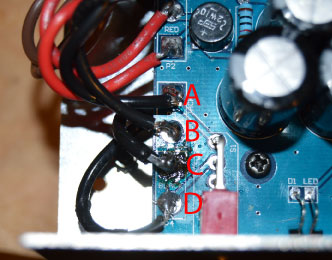Home › Forums › Percolator Tube Amp Forum › Percolator FAQ & Support › PCB testing troubles
Tagged: percolator, troubleshooting
- This topic has 17 replies, 3 voices, and was last updated 6 years, 11 months ago by
Grantus.
-
AuthorPosts
-
Grantus
ParticipantHi, all. New to the forum after buying a Percolator kit recently. Just to preface my question: I’m not new to soldering or simple electronics projects, although my soldering skills are a bit rusty.
So, here it goes. After assembling the PCB board, I’m not getting readings on most test points.
I do get a 119.5VAC reading for AC voltage from the IEC power receptacle. Then when testing the PCB connections, I get just 1.5v (instead of 6.5v) from test point 2 (R17) and I get 1.5v from test point 3 (the LED) connection. Other than that, no readings from any test points.
Do I take it all apart and start again? Any other suggestions?
Thanks
Grant
zdlAdmin
KeymasterHey Grant! Glen here. Sorry your Percolator did not fire up on the first try. Brach the Percolator designer will chime in on Monday. Meanwhile you may want to take a look at this thread for an example of a troubleshoot in progress. Short answer: examine that solder very carefully! Look for bridges — globs of solder that connect things that should not be connected. Look for “cold joints” where the solder did not flow smoothly into the pad and may not be making a good connection where it should.
We’ll get you there.
Grantus
ParticipantThanks, Glen.
I’ll check the troubleshooting thread. I may need to do a bit of PCB repair, because I fried one of the contact pads on edge of the board. I’m sure we’ll figure it out.
Thanks
Grant
brach
ModeratorHi Grant,
This Brach, the electrical designer here at ZDL.
I’m curious what voltage reading you are getting from your power transformer. What AC voltage do you get across the brown wires coming from the power transformer (not from ground, but across the wires)? What AC voltage do you get across the Red wires? What DC voltage do you get at testpont 1 (from ground)?…If you get nothing, are the bridge rectifiers (BR1, BR2) in the correct orientation?
Thanks.
-Brachbrach
ModeratorIf the trace from that pad broke then that would explain why you are not getting any voltage on most of the test points. See if you can make that repair and let me know the results. If you want any help or tips on that process let me know.
Good luck.
-BrachGrantus
ParticipantHi, Brach
Thanks, the pad connecting to one of the black wires coming from the power transformer is the one that got fried. I was able to solder the black wire to the board, but I wonder about the connection.
Test point 1 DC voltage: zero volts.
Red and brown wires from power transformer: zero reading.
brach
ModeratorThat makes since. It seems that the power transformer isn’t getting any voltage…probably because of the damaged pad. Would it be possible to send me some photos of the board where the pad got damaged? If you can’t attach them to the forum post then email them to me…brach “at” zeppelindesignlabs “dot” com
Just to make sure…are you getting ~120vac at P5 (where the wires come in from the IEC jack)?
Thanks.
We’ll get this fixed.
-BrachGrantus
ParticipantHi, Brach
Thanks. I’ll email a picture to you. It may be hard to see. I am getting 120-ish vac at the IEC jack.
brach
ModeratorThanks. I’ll be looking for the pictures.
Are you getting 120ish volts at the board, though (not at the jack)? I just want to be sure the problem is at the transformer input, not another place on the board.
-BrachGrantus
ParticipantHi, Brach
Just emailed the pictures. I am getting 120 volts at P5. Sorry, I misunderstood your earlier questions.
Thanks
Grant
brach
ModeratorThanks for pictures. I edited one of them for reference here…
You say that you have ~120VAC across pads A and B.
Are you getting no voltage across pads C and D?…I’m assuming you get no voltage.
Please test the AC voltage across pads A and D…you should have ~120V with the power switch on, is this correct?
Assuming you don’t have voltage across C and D, the trace from pad C to B must be broken.
With the IEC power cable unplugged and power switch off test for continuity between C and B. They should be connected, but if they are not then the trace is broken. If this is the problem then you need to jump those 2 pads together with some thick wire…use about 1/4″ of the extra transformer wire that you cut off…tin it first and remove the insulation.Upon closer look at the photo, please add a little more solder to pad B and re-flow that joint. Make sure the wire is making good connection to the pad. Do this first, to make sure that is not the problem.

Keep me posted.
Good luck.
-BrachGrantus
ParticipantThanks, Brach
I took the board apart last night to check for potential problems on the solder side, so I’ll try your suggestions when I put it back together. I wasn’t getting voltage across C and D.
Thanks again,
Grant
Grantus
ParticipantOkay … progress, I think. I bridged the P4 and P5 pads, like you suggested, Brach. Amp seems to turn on, but the 120ohm resistor at R15 glows and sparks. Assuming I fried it somehow. Is it soldered wrong? If I order a replacement, what values should I look for in terms of wattage, etc?
Thanks again
Grant
brach
ModeratorIt’s never good when the resistors glow. It means there is too much current going though it. How is it sparking? My guess is that it’s glowing because it’s sparking and not drawing current elsewhere. Does it still spark with the tube removed? Sparking is an indication that it’s shorted (to ground) somewhere, possibly the via between C10, C9, and one of the pads of R15. Make sure you only have enough solder on the resistor pads that you need, and it’s not spilling over to the copper ground plane (or vias) around the pads. It might help to use some electronics flux (not plumbers flux) to clean up your solder joints if necessary. If you can’t see anything obvious from the top side of the board, then you’ll have to take it out and look for shorts on the solder side. Look for black burn marks on the PCB where it was sparking as an indication of where the shot is. Try to refrain from turning it on until you think you’ve found and fixed the problem, otherwise you might blow the fuse.
Good luck.
Let me know what you find.
-Brachbrach
ModeratorTo answer your questions from earlier…
It might not be destroyed…resistors are often more resilient that we think. Measure it and see if it’s still close to 220 ohms. It’s a 220 ohm, 1/2W, 1% tolerance metal film resistor…but you can use any tolerance and type of resistor, as long as it’s 220 ohms and at least 1/2W.
-Brach -
AuthorPosts



